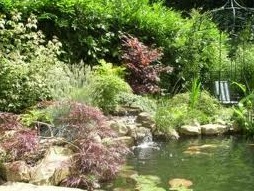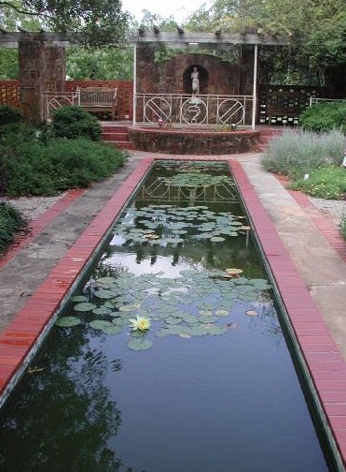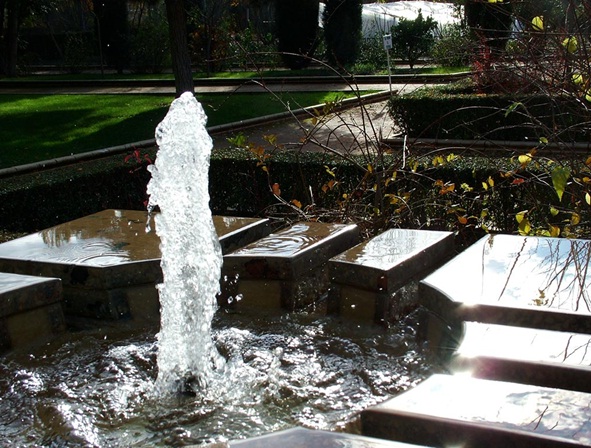Categories
Calendars
Guides
Reviews
Archive
Gallery
Articles
Ask Our Gardening Expert
Planning a Water Garden
The development of low voltage pumps and plastic liners make possible the creation of fountains, artificial streams and waterfalls that were once costly fancies. Water features create an environment that allows you to grow a further range of plants, adding another level of interest.
Ponds
An Informal Pond The Elements of a Formal Pond
Moving Water
A fountain featuring in a formal setting
Water spouts provide the pleasure of running water to the smallest of gardens. They can range from the simplest springs running over stones to small statuary and architecturally shaped features. A simple, low voltage pump circulates water through a pipe from the pool up to an outlet.
A natural-looking waterfall in a small garden
Few gardens are fortunate in having a natural stream. A circulating watercourse falling into a pool or reservoir is possible, making use of changing levels. ‘Canals’ can be made in formal gardens and natural rocks and stones with moisture loving plants can be used to edge streams in informal gardens.
A bog garden can make a transition between land and water
Water is always an appealing feature in any garden and its presence does not need to be limited by garden size. At all times of the year, patterns of sound, movement and reflection make it particularly attractive.
When deciding upon a water feature, we must bear in mind the size and style of garden. In a large, informal garden, a large pond and watercourse is possible. In a small, urban garden, a formal pool may be more suitable. We must bear in mind the safety of children and not form areas of great depth where they may be present.
Ponds are effective where reflections can mirror eye-catching features like statuary, groups of trees or plants. A small pond can act as ‘surprise’ in a secluded area. Check the main viewing points, such as main house windows and seating areas and remember that you need to consider the angle of reflection when deciding upon site. The reflection will appear midway between the viewing point and the feature. Just like land plants, an open, sunny position away from trees is the best place for water plants. Check for the possibility of chemical runoff or leaching from other parts of the garden.
Informal ponds should have an irregular shape and bounded by natural materials to link it with the garden. Plantings around the edges can break up the outline and merge with the garden. In contrast, a formal pond may have a geometric shape and the edges can be of cut stone or pavers to form an additional feature.

The style of moving water must be considered. Fountains are used in more formal settings and as a focal point, adding sound and movement. Splashing water gives an impression of coolness in hot weather and introduces oxygen to the water, benefitting both fish and plants. Some water plants, like water lilies, do not tolerate disturbed water and should be sited some distance away. 

Bog Gardens
A bog garden makes an interesting feature in informal gardens. Next to pond, a bog garden forms a transition between land and water. A pond liner can be adjusted to allow an overspill from the pond or placed under the soil to provide a suitable environment for water tolerant plants. A bog garden is a better use of naturally waterlogged areas rather than installing drains.